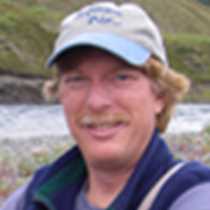Green with shades of grey greeted our day in Glacier Bay as we woke to the National Geographic Sea Lion heading north into one of Alaska’s oldest national parks. Some of our fellow explorers were awakened at 3:00 a.m. to a 5.9 earthquake that was centered about 45 miles west of Gustavus. Reports from the night crew on the dock in Bartlett Cove, where we were waiting for our National Park Service naturalists to board, had the boat rocking and the dock clanking. But since the earthquake was side-to-side along a slip fault, there was no tsunami to worry about.
Our grey stayed steady most of the day, but it didn’t dampen the great wildlife we encountered. South Marble Island served up its noisy cadre of Steller sea lions and those seeking a horned puffin to add to their bird list were not disappointed. Bertha, our guest from Hoonah, told about recently passed legislation in Congress that would allow residents from Hoonah to once again collect glaucous –winged gull eggs from South Marble. The bill is sitting on President Obama’s desk for signature. Bertha said elders in Hoonah are already planning for the first gull egg collection next summer.
Just before Gloomy Knob we spent time with a black wolf lounging in a stream bed. While mostly settled into the grass and, we assume waiting for a mountain goat to wander by – it did get up a couple times and move around, but not out of sight. Everyone on the bow got great looks at one of the rarest wildlife sightings of the entire trip.
At Gloomy Knob the mountain goats were out in force. High on the ridgetop, low by the waterline and several bunches in between gave everyone a chance to see these sure-footed creatures. Bertha told about collecting shed goat hair on the backside of these hills when she was a child and giving the hair to elders in Hoonah to use in making chilkat blankets. And to finish out the terrestrial wildlife trifecta, we watched a brown bear grazing in the grass above the high tide line.
Johns Hopkins Inlet and Johns Hopkins Glacier were our destinations after lunch and the light amount of ice in the water allowed the second mate to deftly steer Sea Lion to within a quarter-mile or so of the glacier, where we sat for over an hour and watched some spectacular calving. Inspired by the real-life glacier, our younger explorers – and some still young at heart – joined in making a replica of the Johns Hopkins Glacier with ice cream, Oreo cookies, chocolate chips and whipped cream…a lesson in edible glaciology!
The day stayed grey as we headed back south, but that didn’t slow down the enthusiasm of our youngest explorers to become Junior Rangers. The final tasks for their Junior Ranger pins were reports given to the whole ship at recap on their favorite animal. Our junior “shipboard naturalists in training” shared with us that brown bears “eat everything but granite;” sea otter fur is over one million hairs in a square inch; mountain goats have “suction-cup hooves” to keep them from falling; ermine are brown in the summer and white in the winter; porcupine are the size of a “spoiled cat”; jellyfish are the largest plankton; and “moose just got added to the menu” for wolves.
Glacier Bay totally lived up to Wallace Stegner’s observation that national parks are “America’s best idea.”







